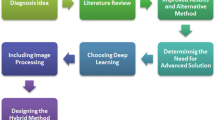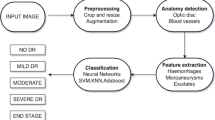Abstract
Diabetic retinopathy is one of the major causes of the vision loss worldwide. Its timely detection is critical for planning an efficient treatment process. Typically, fundus images are taken for diagnosis of diabetic retinopathy and determining its corresponding severity level. In this study, a framework that uses a mobile edge device for detecting the severity level of diabetic retinopathy is proposed. For this purpose, a dataset of fundus images containing five different diabetic retinopathy severity levels is utilized. The mobile device is responsible for performing the edge processing operations in which the fundus images are preprocessed by cropping, unsharp masking, and resizing. The preprocessed images are then transmitted to a cloud computing platform over the internet. In the cloud server, a concatenation ensemble deep learning models is trained for detecting the severity level of the diabetic retinopathy. The ensemble model involves three benchmark convolutional neural network architectures that are EfficientNetB7, ResNet50, and VGG19. The classification accuracy achieved using the concatenation ensemble is 96%, which is higher than those obtained via individual convolutional neural network models. In addition, contributions of edge computing are shown by calculating the total amount of transmitted data and the response time from the cloud server. It was observed that for classifying the entire test set 2984.52 Kb of less data, corresponding to average data size reduction of 85.2%, was transmitted and the response time was reduced by 6.14 seconds when the preprocessing steps are performed at the edge device.










Similar content being viewed by others
Data availability
The datasets analysed during the current study are available in the Kaggle repository, https://www.kaggle.com/c/aptos2019-blindness-detection/data
References
Al-Karawi A, Avşar E (2022) Stacked cross validation with deep features: a hybrid method for skin Cancer detection. Tehnički glasnik 16(1):33–39
Allyn W., https://www.welchallyn.com/en.html. Accessed on April 20, 2021.
Antal B, Hajdu A (2012) An ensemble-based system for microaneurysm detection and diabetic retinopathy grading. IEEE Trans Biomed Eng 59(6):1720–1726
Antal B, Hajdu A (2014) An ensemble-based system for automatic screening of diabetic retinopathy. Knowl-Based Syst 60:20–27
APTOS, https://www.kaggle.com/c/aptos2019-blindness-detection/data. Accessed on April 20, 2021.
Avşar E (2021) Effects of Image Preprocessing on the Performance of Convolutional Neural Networks for Pneumonia Detection. In: 2021 International Conference on INnovations in Intelligent SysTems and Applications (INISTA)
Avşar E, Salçin K (2019) Detection and classification of brain tumours from MRI images using faster R-CNN. Tehnički glasnik 13(4):337–342
Bhandary A, Prabhu GA, Rajinikanth V, Thanaraj KP, Satapathy SC, Robbins DE, Shasky C, Zhang YD, Tavares JMRS, Raja NSM (2020) Deep-learning framework to detect lung abnormality – a study with chest X-ray and lung CT scan images. Pattern Recogn Lett 129:271–278
Butt MM, et al (2022) Diabetic Retinopathy Detection from Fundus Images of the Eye Using Hybrid Deep Learning Features. Diagnostics. 12(7).
Chaturvedi SS, et al (2020) Automated diabetic retinopathy grading using deep convolutional neural network. arXiv preprint arXiv:2004.06334
Chen M, Li W, Hao Y, Qian Y, Humar I (2018) Edge cognitive computing based smart healthcare system. Futur Gener Comput Syst 86:403–411
Dayana AM, Emmanuel WRS (2022) An enhanced swarm optimization-based deep neural network for diabetic retinopathy classification in fundus images. Multimed Tools Appl 81(15):20611–20642
Decencière E, Zhang X, Cazuguel G, Lay B, Cochener B, Trone C, Gain P, Ordonez R, Massin P, Erginay A, Charton B, Klein JC (2014) Feedback on a publicly distributed image database: the Messidor database. Image Analy Stereol 33(3):231–234
Diabetic retinopathy screening: a short guide (2020) Increase effectiveness, maximize benefits and minimize harm. Copenhagen: WHO Regional Office for Europe; Licence: CC BY-NC-SA 3.0 IGO
Fatima et al (2022) A unified technique for entropy enhancement based diabetic retinopathy detection using hybrid neural network. Comput Biol Med 145:105424
Fu Y et al (2020) Deep learning in medical image registration: a review. Phys Med Biol 65(20):20TR01
Garibaldi-Beltrán JA, Vazquez-Briseno M (2012) Personal Mobile Health Systems for Supporting Patients with Chronic Diseases. In: 2012 IEEE ninth electronics, Robotics and Automotive Mechanics Conference
Ghoneim A, Muhammad G, Amin SU, Gupta B (2018) Medical image forgery detection for smart healthcare. IEEE Commun Mag 56(4):33–37
He K, et al. (2016) Deep residual learning for image recognition. In: Proceedings of the IEEE conference on computer vision and pattern recognition
Karakaya M, Hacisoftaoglu RE (2020) Comparison of smartphone-based retinal imaging systems for diabetic retinopathy detection using deep learning. Bmc Bioinform 21:259
Kassani SH et al (2019) Diabetic retinopathy classification using a modified xception architecture. In: 2019 IEEE international symposium on signal processing and information technology (ISSPIT). IEEE
Khalifa NEM, Loey M, Taha MHN, Mohamed HNET (2019) Deep transfer learning models for medical diabetic retinopathy detection. Acta informatica medica : AIM : journal of the Society for Medical Informatics of Bosnia & Herzegovina : casopis Drustva za medicinsku informatiku BiH 27(5):327–332
Khanamiri HN, Nakatsuka A, El-Annan J (2017) Smartphone fundus photography. Jove-J Visualized Exp 125
Kingma DP, Ba J (2014) Adam: A method for stochastic optimization. arXiv preprint arXiv:1412.6980
Lam C, Yi D, Guo M, Lindsey T (2018) Automated detection of diabetic retinopathy using deep learning. AMIA Joint Summ Trans Sci Proc AMIA Joint Summ Trans Sci 2017:147–155
Liu Z, et al (2020) Deep learning based brain tumor segmentation: A survey. arXiv preprint arXiv:2007.09479
Lv Z, et al (2010) iCare: a mobile health monitoring system for the elderly. In: 2010 IEEE/ACM Int'l conference on green computing and Communications & Int'l conference on cyber, physical and social computing. . IEEE
Maamari RN, Keenan JD, Fletcher DA, Margolis TP (2014) A mobile phone-based retinal camera for portable wide field imaging. Br J Ophthalmol 98(4):438–441
Maier A, Syben C, Lasser T, Riess C (2019) A gentle introduction to deep learning in medical image processing. Z Med Phys 29(2):86–101
Majumder S, et al (2020) A deep learning-based smartphone app for real-time detection of five stages of diabetic retinopathy. in Real-Time Image Processing and Deep Learning 2020. International Society for Optics and Photonics.
Mateen M et al (2019) Fundus image classification using VGG-19 architecture with PCA and SVD. Symmetry 11(1):1
Murugappan M, Prakash NB, Jeya R, Mohanarathinam A, Hemalakshmi GR, Mahmud M (2022) A novel few-shot classification framework for diabetic retinopathy detection and grading. Measurement 200:111485
Mushtaq G, Siddiqui F (2021) Detection of diabetic retinopathy using deep learning methodology. IOP Conf Series: Materials Sci Eng 1070(1):012049
Pires R, Avila S, Wainer J, Valle E, Abramoff MD, Rocha A (2019) A data-driven approach to referable diabetic retinopathy detection. Artif Intell Med 96:93–106
Pratt H, Coenen F, Broadbent DM, Harding SP, Zheng Y (2016) Convolutional neural networks for diabetic retinopathy. Procedia Comput Sci 90:200–205
Qummar S, Khan FG, Shah S, Khan A, Shamshirband S, Rehman ZU, Ahmed Khan I, Jadoon W (2019) A deep learning ensemble approach for diabetic retinopathy detection. IEEE Access 7:150530–150539
Qureshi I, Ma J, Abbas Q (2019) Recent development on detection methods for the diagnosis of diabetic retinopathy. Symmetry 11(6):749
Qureshi I, Ma J, Abbas Q (2021) Diabetic retinopathy detection and stage classification in eye fundus images using active deep learning. Multimed Tools Appl 80(8):11691–11721
Rajalakshmi R, Subashini R, Anjana RM, Mohan V (2018) Automated diabetic retinopathy detection in smartphone-based fundus photography using artificial intelligence. Eye 32(6):1138–1144
Saini M, Susan S (2020) Deep transfer with minority data augmentation for imbalanced breast cancer dataset. Appl Soft Comput 97:106759
Sajana T et al (2019) Classifying diabetic retinopathy using deep learning architecture. Int J Innov Technol Explor Eng 8(6):1273–1277
Shaik NS, Cherukuri TK (2022) Hinge attention network: a joint model for diabetic retinopathy severity grading. Appl Intell 52:15105–15121
Shanthi T, Sabeenian RS (2019) Modified Alexnet architecture for classification of diabetic retinopathy images. Comput Electr Eng 76:56–64
Simonyan K, Zisserman A (2014) Very deep convolutional networks for large-scale image recognition. arXiv preprint arXiv:1409.1556
Sodhro AH, Luo Z, Sangaiah AK, Baik SW (2019) Mobile edge computing based QoS optimization in medical healthcare applications. Int J Inf Manag 45:308–318
Soleymanifard M, Hamghalam M (2022) Multi-stage glioma segmentation for tumour grade classification based on multiscale fuzzy C-means. Multimed Tools Appl 81(6):8451–8470
Sreng S, Maneerat N, Hamamoto K, Panjaphongse R (2018) Automated diabetic retinopathy screening system using hybrid simulated annealing and ensemble bagging classifier. Appl Sci 8(7):1198
Subha T, et al (2021) Analysis of Diabetic Retinopathy and Its Causes Using Fuzzy C-Means Model. In: 2021 4th International Conference on Computing and Communications Technologies (ICCCT)
Tan M, Le Q (2019) Efficientnet: rethinking model scaling for convolutional neural networks. In international conference on machine learning. PMLR
Taufiqurrahman S, et al (2020) Diabetic Retinopathy Classification Using A Hybrid and Efficient MobileNetV2-SVM Model. in 2020 IEEE REGION 10 CONFERENCE (TENCON)
Tymchenko B, Marchenko P, Spodarets D (2020) Deep learning approach to diabetic retinopathy detection. arXiv preprint arXiv:2003.02261
Wan S, Liang Y, Zhang Y (2018) Deep convolutional neural networks for diabetic retinopathy detection by image classification. Comput Electr Eng 72:274–282
Wang X, et al (2018) Diabetic retinopathy stage classification using convolutional neural networks. In 2018 IEEE international conference on information reuse and integration (IRI). IEEE.
Web page, https://developer.android.com/studio. Accessed 20 Apr 2021
Web page, https://www.d-eyecare.com/. Accessed 20 Apr 2021
World Health Organization, https://www.who.int/news-room/fact-sheets/detail/blindness-and-visual-impairment. Accessed 20 Apr 2021
Zheng Y, He M, Congdon N (2012) The worldwide epidemic of diabetic retinopathy. Indian J Ophthalmol 60(5):428–431
Author information
Authors and Affiliations
Corresponding author
Ethics declarations
Conflict of interest
None.
Additional information
Publisher’s note
Springer Nature remains neutral with regard to jurisdictional claims in published maps and institutional affiliations.
Rights and permissions
Springer Nature or its licensor (e.g. a society or other partner) holds exclusive rights to this article under a publishing agreement with the author(s) or other rightsholder(s); author self-archiving of the accepted manuscript version of this article is solely governed by the terms of such publishing agreement and applicable law.
About this article
Cite this article
Al-Karawi, A., Avşar, E. A deep learning framework with edge computing for severity level detection of diabetic retinopathy. Multimed Tools Appl 82, 37687–37708 (2023). https://doi.org/10.1007/s11042-023-15131-4
Received:
Revised:
Accepted:
Published:
Issue Date:
DOI: https://doi.org/10.1007/s11042-023-15131-4




